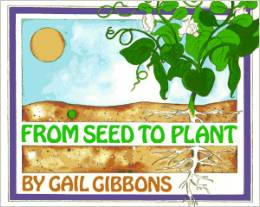 As gardeners we all appreciate that many plants produce seeds that later grow into new plants. Young children, on the other hand, may have no idea where plants come from and the whole concept of a life cycle is probably foreign to them. Gail Gibbons’ book, From Seed to Plant, introduces these ideas on an elementary level, providing enough detail for the curious child while keeping the text simple.
As gardeners we all appreciate that many plants produce seeds that later grow into new plants. Young children, on the other hand, may have no idea where plants come from and the whole concept of a life cycle is probably foreign to them. Gail Gibbons’ book, From Seed to Plant, introduces these ideas on an elementary level, providing enough detail for the curious child while keeping the text simple.
Gibbons begins with the idea that plants producing both vegetables and flowers make seeds and she has a full page showing different kinds of seeds. She makes the point that seeds produce the same kind of plant that made them and then turns to the anatomy of a flower with a labeled diagram. The diagram includes the stigma, pistil, stamens, pollen and ovules as well as petals and sepals. The following pictures show pollination wind, insects, and birds culminating in a diagram of a flower with the pollen tube growing into the ovary. Seed and fruit development is described and seed distribution by wind, water, and animals is shown. Of course, people are also shown planting seeds they buy in packets. The classic picture of a bean seed with embyo, food reserve, and seed coat is explained and the conditions leading to seed germination are shown. The author describes the growth of the root, then the shoot, and finally the emergence of green leaves that produce food for the plant as it grows to maturity and produces more flowers and seeds. The life cycle is complete and we all enjoy eating the seeds, fruits, and pods of many plants. Instructions for raising bean plants are given and a fact sheet is provided; did you know that the largest flower in the world is four feet across and weighs up to twenty-five pounds? Amazing!
The book is recommended for children kindergarden to second grade. It can be read to the younger children without the amount of detail that an older child may appreciate, and that is the beauty of the book; include more as interest increase. The concepts are clearly presented and enhanced by the illustrations that show what the text is saying in words. The author employs lots of bright color and bold figures to make the illustrations both attractive and useful. To teach the concept of seeds growing into plants I would start with the project described in the book (growing bean seeds) and then begin reading this book once germination had occurred. In this way the child would have hands on experience with the topic before being introduced to the terminology and more intellectual aspects of it. Great book for expanding the experiences of young children.
To buy From Seed to Plant from Amazon.com click here.